TravelDeparture Gate: Margaret River, Western Australia
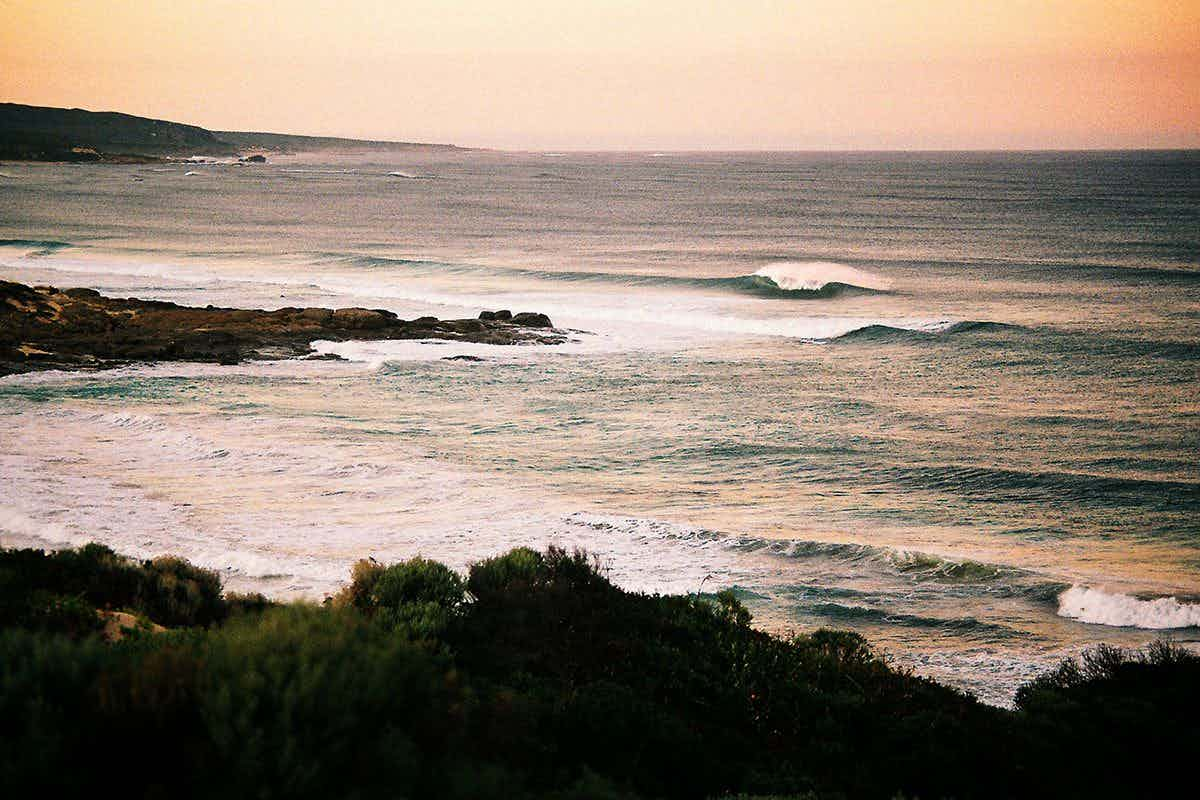
As good a reason as any to visit WA in search of waves. Photo: Mat Arney
Western Australia is a massive and remote state, and these are characteristics that it shares with many of the waves that break on its shores. Surfing here is often a raw and powerful experience, making it a prime destination for surfers wanting to quietly test their mettle, and the baseline ability and versatility of some of the state’s high profile surfers (it produces a lot for such a relatively small population) gives away the reality that, away from the spotlight, the region boasts a wide variety of waves.
A solid half of Western Australia’s enormous Indian Ocean coastline (over 12,000km/7,500 miles) is open to the brunt of swells generated in the roaring forties of the Southern Ocean, which eventually break on Indonesian reefs. Between the mutant tow-only slabs of the south coast and the grinding left-hand barrels of the desert north, there is a lot of ground to cover. Sitting on the dividing line between the Indian Ocean and an enormous, largely desert, continental landmass, WA has a reputation for being both very sunny and very windy – the state capital Perth is widely regarded to be the sunniest capital city and the third windiest, on the planet – so surfing before the sea breeze (known locally as “The Fremantle Doctor”) blows up is essential. Perth is almost every visitor’s arrival point; it is the most remote capital city and is closer to Indonesia’s capital city Jakarta than to it’s own federal capital or any of the major population centres on Australia’s east coast, however the orientation and bathymetry of Perth’s bay means that the metropolitan beaches rarely get above head high and often close-out, as well as being crowded, so visiting surfers will need to head further afield.
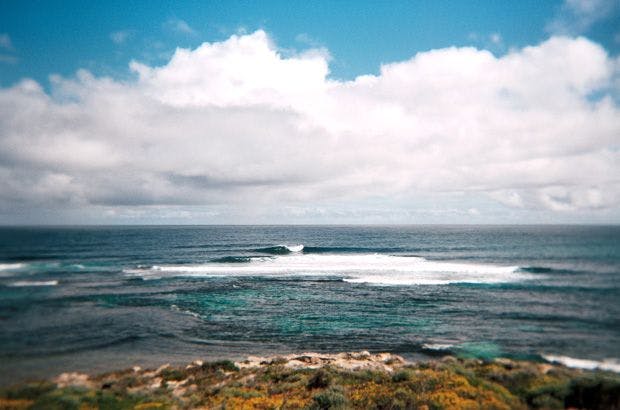
A three and a half hour drive south, the Margaret River area in the state’s south west is a world famous wine region, and autumn is prime season for harvesting both grapes and good waves. “Margs” sits midway down a 135km long outcrop of limestone between Cape Naturaliste (North) and Cape Leeuwin (South), and between the two lighthouses just to the west of Caves Road are hidden somewhere in the region of 75 surf spots breaking over reefs, beaches and the occasional point.
The short central stretch of coast directly west of the town of Margaret River around Prevelly and Gnarabup is a particularly productive stretch, and with paved roads and regular parking lots it is probably the most popular. Turning off Caves Road onto Walcliffe Road towards the coast, as you crest the brow of the final hill you’ll see the famous Main Break, also known as “Surfer’s Point” dead ahead. Taking the right onto the road that bears the same name, you’ll come to the main car park overlooking Mains; just to the north out in the bay you’ll be able to spy The Box if it’s breaking, whilst a short distance further on around the road as it bends back around the point you’ll find Rivermouth in the middle of the bay. The Box is a world famous and world class wave, so called because it breaks so square. Breaking over a shallow ledge of reef half a mile offshore, The Box is one for the experts only that requires a surfer to backdoor the peak and drive through a ledgy barrel. When it’s breaking well there will be several skis and boats in the channel, with local and visiting pros getting tubed for the cameras. It’s best with a bit more west in the swell, and in an easterly (offshore) wind. In the middle of the bay, Rivermouth is a punchy and section beachbreak where many of the local stand-out juniors caught their first waves.
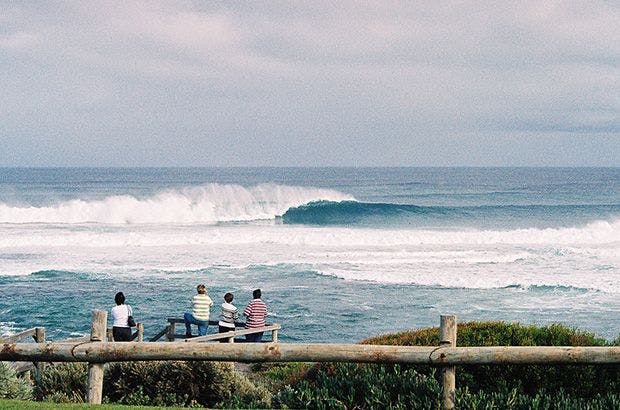
Mainbreak is a super consistent reef that makes the most of any swell and holds a lot of size. There are steps down from the large car park, and a keyhole in the reef right at the bottom of the steps through which you can paddle out and around the deep channel beside the left. Up to around six foot there’s a right and a left, however there is no real channel on the right and surfing too far or getting caught inside there isn’t a recipe for fun. Over six foot the right stops being an option, whilst the left starts getting really good at around eight foot and can easily hold double that. Waves here are characterized by steep elevator drops and large walls that require classic rail-to-rail carves all the way to the deep channel, hence the wave’s fall from favour with recent generations of surfers for who it holds few high performance possibilities and the reason that younger locals have nicknamed it “Jurassic Park”. Nevertheless, Mainbreak is a classic wave that still offers a great deal of challenge, and the possibility to paddle into some real raw power, to many visiting surfers.
On the south side of the Surfer’s Point reef is Southsides, which offers a righthander if Mains gets too crowded. The next two breaks as you look south are legitimate big wave spots. Across the channel from Southsides sits Bombie, which is often a lot larger than it looks from either the car park or Southsides. Further south, out around the corner from the boat ramp, is Boatramps, a large, long, left that requires a big gun and a lot of confidence in significant sized surf.
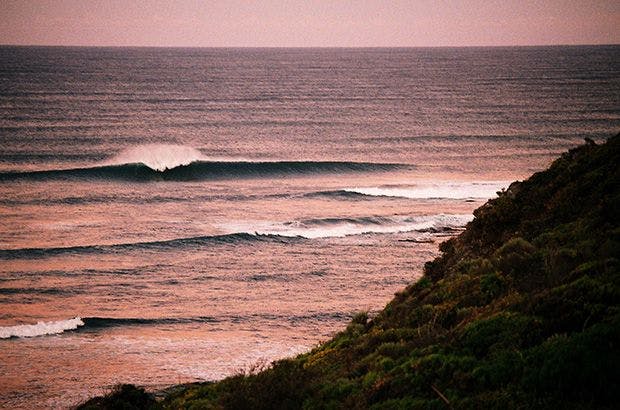
As you keep heading south and link back up with Walcliffe Road, you’ll move from Prevelly into Gnarabup. There are several car parks as you reach the southernmost point of the settlements and the road loops back around on itself; one overlooks Grunters and Gas Reef, whilst the other is directly in front of Gas Reef. Grunters is a popular yet challenging wave, breaking out of deep water and moving a lot of energy with it. The right-breaking barrel is high and tight, and the wave is more challenging than the locals make it look from the car park lookout. On the other side of the small bay is Gas reef. Breaking in front of a small rocky point over relatively flat granite reef, Gas does a fair impression of its cousin up the coast, The Box. An A-frame peak with short lefts and longer rights that sometimes link up with the beach break, Gas offers an almost guaranteed barrel if you can get in position to backdoor the peak; sitting directly on the peak or trying to takeoff on the shoulder is a recipe for getting pitched here. As you move south down the beach from Gas towards Boodjidup there are various peaks and sections that work well on the predominant southwest swells and south-southeast winds, and the further you walk the less crowded those peaks will be. Often, a long trek down the soft sand beach is well rewarded.

The final spot in this small area requires you to head back out to Caves Road and head a few miles further south through the forest and bush. Take a right turn back towards the coast on Redgate Road, and follow the road to Redgate beach at the end. Inside a slightly more sheltered bay, backed by sand dunes and granite boulders, Redgate is a fun beachbreak that can often offer more manageable conditions when the main Margies stretch is getting “a bit too much”. It works on the same swell and wind directions, but is slightly more user friendly to those not so well confident in backdooring heavy waves over shallow reefs.
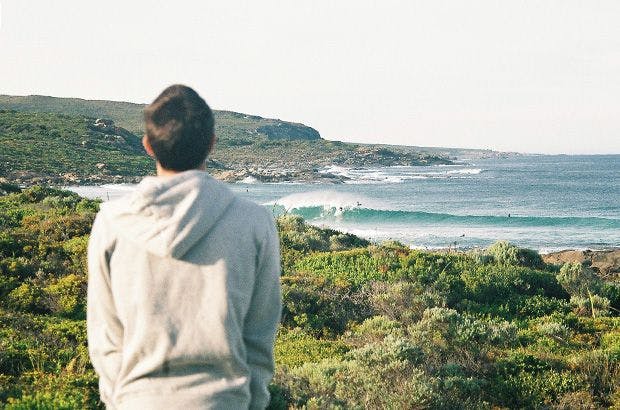
The Margaret River region of Western Australia has a lot to offer visiting surfers; the quality of waves when compared to the crowds is highly favourable, and makes it instantly obvious why so many talented surfers in each generation hail from this corner of WA. The waves here are powerful and demand attention to the basics of making the drop, a solid bottom turn and a good rail game before anything else, but the rewards can be some of the best and possibly biggest waves available, and certainly without the sort of crowds that you’d expect at comparable spots somewhere like Hawaii. Whilst the southwest of WA is remarkable consistent, any local surfer will advise you never to drive away from surfable waves as it’s not uncommon to spend the best part of a day car-park hopping only to have the wind beat you to the best break.
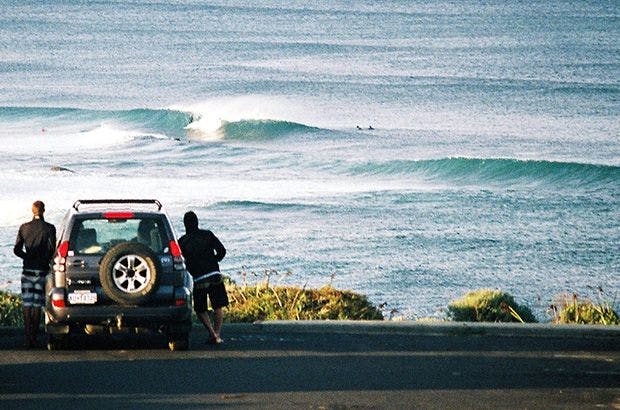
In the summer months the swells are smaller but more manageable for most, however the higher temperatures result in the sea breeze blowing up earlier. During the winter months when Indonesia enjoys large and well-groomed swells, those same swells are often accompanied by strong onshores and poor weather on the southwest coast of WA, closer to their source. The shoulder seasons of spring and, in particular, autumn, are the best seasons to get good waves with favourable winds. It’s worth mentioning the shark issue in WA, which may keep some surfers away, but that is something for each individual to research and come to their own decisions about whether or not they wish to spend time in the sea here. Should you have to spend some time out of the water during a visit then the region is well geared to tourism, and with so many vineyards and wineries in the area a tasting tour is a great way to spend a windy afternoon. There are numerous fantastic restaurants, not to mention art galleries, forests and caves to visit, however if there’s swell then you’ll probably simply pause for a meat pie from the general store in between surfs.
WHERE: Fly to Perth International Airport (PER)
WHEN: March to May
WHY: Powerful, barreling, waves.
HOW: Shortboard, step-up, and a gun if you fancy taking on the big stuff. Take spare boards and spare leashes (you’ll snap at least one of each) and lots of sunscreen.